Warmth and Luminosity in Mustard Yellow
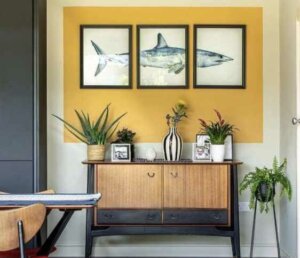
Your house should be a reflection of your personality. Therefore, it’s important to create a pleasant and welcoming environment. We’re going to take a look at the warmth and luminosity of mustard yellow.
Remember, your brain gets used to things that you see every day. However, if you’re surrounded by decoration you don’t like that much, you can get tired of it and stress your mind.
Therefore, the importance of choosing colors correctly is essential. If you make a mistake or simply choose without thinking, you’ll have to live with the results.
Aesthetic perception of mustard yellow
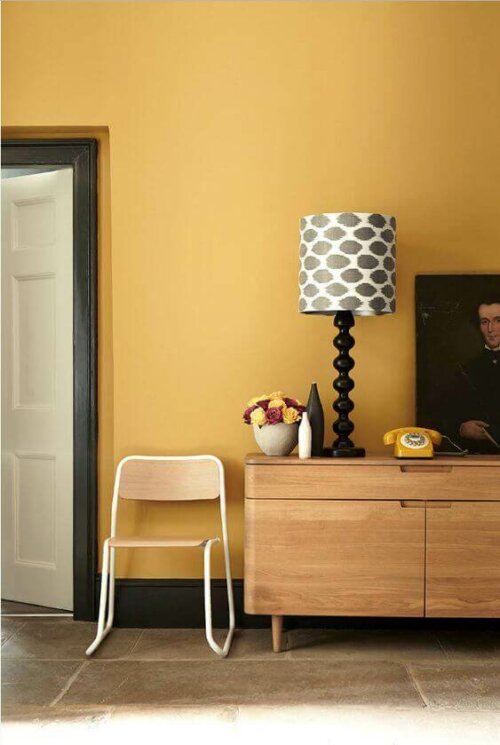
Mustard yellow is classified within the warm range of colors. It’s slightly darker than yellow and approaches a more earthy, ocher look. As a result, it helps generate luminosity and vivacity.
However, this isn’t a muted tone that’s going to be overshadowed by other colors. It has a particular intensity and stands out no matter where you use it. It can be a point of attraction and focus.
On the other hand, you need to be careful about how you use this color. Depending on what style you want to create, the combination with the rest of the room requires balanced tones. You should avoid using too many colors or using cold colors with mustard yellow.
Harmony in decoration helps create a comfortable place that promotes well-being
3 ways to use mustard yellow in the living room
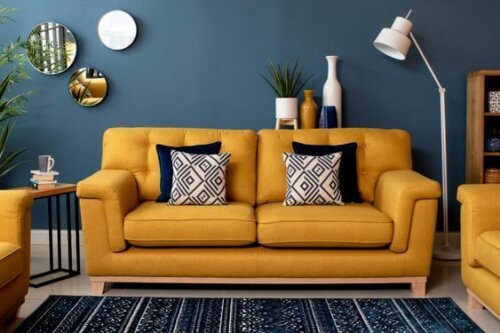
One of the rooms where this color works best is the living room. This is because it adds warmth and positivity, as well as dynamism, joy, and enthusiasm. Let’s look at three ways to use it:
- Create a space that envelops you by covering the walls in this color. However, you can also alternate it with a neutral tone like gray or white on the ceiling.
- Can you use this color on seats? Absolutely! Mustard yellow on sofas or a chair is an amazing option since it makes them a central focus. On the other hand, remember that you should pair this with neutral tones on the walls to avoid creating any tension.
- If you want to use this color on something smaller, you can use it on the floor with a carpet or on sofa cushions. It can look great contrasted with indigo or blue.
It’s worth highlighting how this color goes with wood as it adds to the warmth of wood furniture or a wooden floor.
Mustard yellow for the exterior of the house
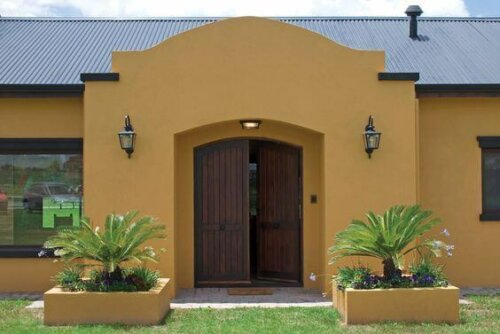
We’re used to talking about colors in interiors, but what about the best colors for exteriors? Mustard yellow is one of those colors, especially when paired with a rustic style.
Generally, you can find this color in the paint for facades. Also, if you’re looking for colors to combine with it, whites and grays are good choices. Because this color is warm it goes well with certain roof tiles and also looks great with green plants.
Many buildings in cities tend to use this color, although perhaps in a paler shade. Why? Generally, people use this color because it’s warm and pleases the eye with its luminosity.
Using this color in your bedroom
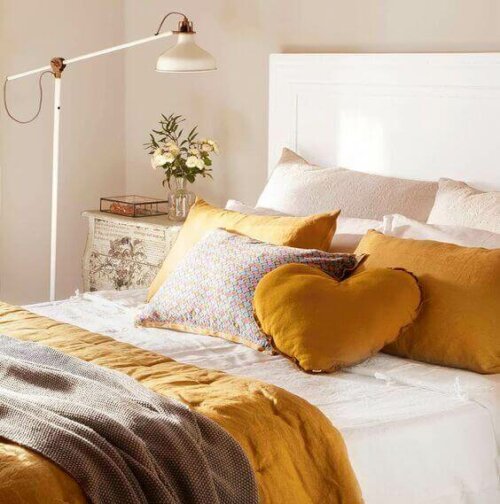
Bedrooms are private places where we can demonstrate our personalities. Mustard yellow can be striking, active, and energetic. Therefore, it’s important to contrast it with calmer colors, such as white, gray, or earth tones.
This color can stand out on the walls. However, if you want to use it in a smaller area, choose a blanket, bed cushions, or an armchair, or put it just on one wall.
The goal is to use it as a pop of color without oversaturating the room.
Your house should be a reflection of your personality. Therefore, it’s important to create a pleasant and welcoming environment. We’re going to take a look at the warmth and luminosity of mustard yellow.
Remember, your brain gets used to things that you see every day. However, if you’re surrounded by decoration you don’t like that much, you can get tired of it and stress your mind.
Therefore, the importance of choosing colors correctly is essential. If you make a mistake or simply choose without thinking, you’ll have to live with the results.
Aesthetic perception of mustard yellow

Mustard yellow is classified within the warm range of colors. It’s slightly darker than yellow and approaches a more earthy, ocher look. As a result, it helps generate luminosity and vivacity.
However, this isn’t a muted tone that’s going to be overshadowed by other colors. It has a particular intensity and stands out no matter where you use it. It can be a point of attraction and focus.
On the other hand, you need to be careful about how you use this color. Depending on what style you want to create, the combination with the rest of the room requires balanced tones. You should avoid using too many colors or using cold colors with mustard yellow.
Harmony in decoration helps create a comfortable place that promotes well-being
3 ways to use mustard yellow in the living room

One of the rooms where this color works best is the living room. This is because it adds warmth and positivity, as well as dynamism, joy, and enthusiasm. Let’s look at three ways to use it:
- Create a space that envelops you by covering the walls in this color. However, you can also alternate it with a neutral tone like gray or white on the ceiling.
- Can you use this color on seats? Absolutely! Mustard yellow on sofas or a chair is an amazing option since it makes them a central focus. On the other hand, remember that you should pair this with neutral tones on the walls to avoid creating any tension.
- If you want to use this color on something smaller, you can use it on the floor with a carpet or on sofa cushions. It can look great contrasted with indigo or blue.
It’s worth highlighting how this color goes with wood as it adds to the warmth of wood furniture or a wooden floor.
Mustard yellow for the exterior of the house

We’re used to talking about colors in interiors, but what about the best colors for exteriors? Mustard yellow is one of those colors, especially when paired with a rustic style.
Generally, you can find this color in the paint for facades. Also, if you’re looking for colors to combine with it, whites and grays are good choices. Because this color is warm it goes well with certain roof tiles and also looks great with green plants.
Many buildings in cities tend to use this color, although perhaps in a paler shade. Why? Generally, people use this color because it’s warm and pleases the eye with its luminosity.
Using this color in your bedroom

Bedrooms are private places where we can demonstrate our personalities. Mustard yellow can be striking, active, and energetic. Therefore, it’s important to contrast it with calmer colors, such as white, gray, or earth tones.
This color can stand out on the walls. However, if you want to use it in a smaller area, choose a blanket, bed cushions, or an armchair, or put it just on one wall.
The goal is to use it as a pop of color without oversaturating the room.
All cited sources were thoroughly reviewed by our team to ensure their quality, reliability, currency, and validity. The bibliography of this article was considered reliable and of academic or scientific accuracy.
- Lluch, Francisco Javier: Arte de armonizar los colores, Barcelona, Imprenta de El Provenir, 1858.







